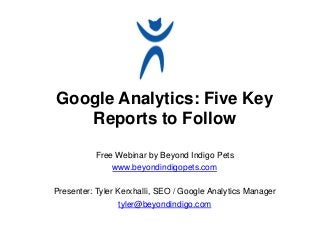
Bi 5 ga_reports_to_follow
- 1. Google Analytics: Five Key Reports to Follow Free Webinar by Beyond Indigo Pets www.beyondindigopets.com Presenter: Tyler Kerxhalli, SEO / Google Analytics Manager tyler@beyondindigo.com
- 2. What is Google Analytics? • Google Analytics is client-side web analytics tool, which is used to track visitor interaction with your website. • This tool runs off piece of JavaScript that we embed within your website. • All of the data is then collected in one centralized location, where it is then organized into a number of viewable reports. • Best of all, its free!
- 3. Where do I get started? Getting started is much easier than you probably think. 1. Create a Google Analytics account, which can be done at: www.google.com/analytics 2. Install the Google Analytics JavaScript tracking code on your website. This is located in the “Admin” area. 3. That’s it! Time to start collecting data.
- 4. Okay, logged in. Now what? • First, spend some time clicking around! • Most of the data for your website will be found under the “Reporting” tab of your Google Analytics account. • Most importantly, don’t get overwhelmed. It is a lot of data to see at one time, but the more time you spend with it the easier it will be to understand.
- 5. What do these metrics mean? Before we talk about the important Avg. Visit Duration: this helps you to reports, here are a few definitions know how much time the average for us to look at: viewer spent on your website. Unique Visitors: this shows you how many individuals accessed your website (to distinguish between visits and visitors). Bounce Rate: a bounce is when someone visits one of your pages, and then leaves without viewing any other pages. Pageviews: the number of pages on your website that were visited during the specified time period.
- 6. Finding reports that matter You are being given a substantial amount of data in these reports. You’ll find that some just don’t have much relevance to you. Since you only have so much time to spend with this, try to focus on: • What matters most to my business? • Where can we get the most actionable data? Well, here are a few reports to start you off…
- 7. Audience Overview To get to this report: Reporting Audience Overview What you can find out: • Basic information on visitors to your website. • Where are your visitors coming from?
- 8. Visitor Flow To get to this report: Reporting Audience Visitor Flow What you can find out: • Where visitors enter your website, and where they drop off. • Visitors Flow is a visual representation of the visitor data for your website.
- 9. Traffic Sources Overview To get to this report: Reporting Traffic Sources Overview What you can find out: • How clients get to your website. • Breakdown the different types of traffic. • Common landing pages on your website.
- 10. Referrals To get to this report: Reporting Traffic Sources Sources Referrals What you can find out: • Tracking ROI on online advertising. • Paying for Yellow Pages? What does it get you?
- 11. Pages To get to this report: Reporting Content Site Content All pages What you can find out: • The most popular pages on your website. • What pages your visitors are spending their time on.
- 12. Setting your own benchmarks How do you put the reports in context? You do it by setting benchmarks for your website! • Compare reports from month to month. • Compare the same period from year-to- year. • Keep on top of your Google Analytics information, don’t take the “Set and forget” approach. This is the first step to improving your website performance, and doesn’t even take much time!
- 13. Want to know more? Two options: Talk to me: Visit the Google Analytics Learning tyler@beyondindigo.com page. Lots of great info! If you want to set up a time to go http://www.google.com/analytics/lea over your account or any advanced rn/ features I would be happy to do so.
- 14. Questions? Feel free to ask now! You can do that in the little GoToMeeting Window. Or contact me later: Tyler Kerxhalli SEO / Google Analytics Manager Beyond Indigo (877) 244-9322 x312 tyler@beyondindigo.com *I’d also be happy to email you this slideshow!
